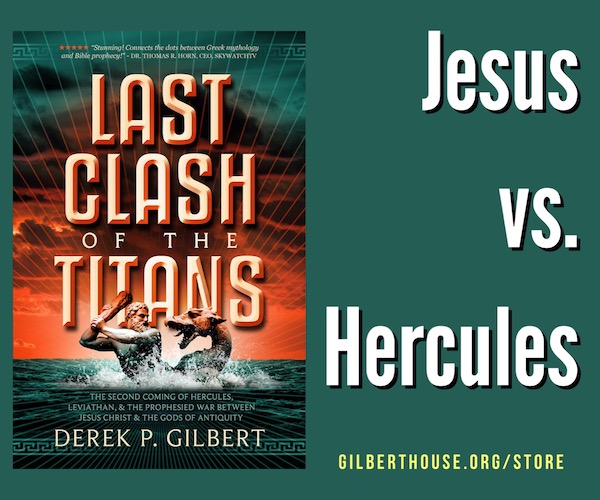Derek’s book Last Clash of the Titans was inspired by a belief that the study of end-times prophecy has been too focused on the human participants in the last great battle of the age. That’s understandable; we humans see the world as though we’re the main character in a movie playing inside our head. We think it’s all about us. And in a sense, that’s true—this war is all about us.
But the rebellion began with the entities created before mankind, the angels—cherubim, seraphim, malakim, Watchers, and, later, the hybrid progeny of the Watchers, the Nephilim, who were linked to the Rephaim by the Hebrews. Nations that developed writing later, such as the Greeks and Romans, called the old gods by different names, but the stories are too consistent for them not to have been passed from one culture to another over the centuries.
As a Christian, we accept the testimony of Jesus that the Old Testament is historically accurate. So, the account of this supernatural war in the Bible is the one we can trust. The prophecies of what’s to come are sure as well, although we won’t see the pictures clearly until the events are right on top of us, assuming the church is still here when these things come to pass.
The subject of the Nephilim/Rephaim has intrigued Christians for millennia. As we’ve noted, the early church fathers mainly agreed that Genesis 6:1–4 meant what it said: There were giants on the earth long ago, the offspring of angels and human women. Further, their spirits were the demons that plague mankind. These spirits, and their fathers now imprisoned in Tartarus, will make up the army of the Antichrist at Armageddon.
There’s no question humans will be involved. Regardless of the timing of the Rapture, the “restrainer” of 2 Thessalonians 2:6 will be out of the way by the time of the showdown at Armageddon, so there will be nothing to prevent these demonic spirits from commandeering the armies of the unbelieving world. Why wouldn’t the warriors of Baal volunteer for an all-out assault on Yahweh’s mount of assembly? Based on the low opinion of humans they demonstrated in the Bible, they consider us expendable at best. Demons made their victims sick, blind, mute, and self-destructive, forcing their hosts to cut themselves and throw themselves into fire. If their human hosts perish in the attack, well, there are more where they came from.
Isn’t it interesting that the greatest fear expressed by the demons Jesus cast out was being commanded “to depart into the abyss”?[1] That’s where their supernatural parents are incarcerated. If anything, those rebel gods hate us even more than the demons do. Why? As Paul wrote, “Do you not know that we are to judge angels?”[2] Exactly how that will work, we have no idea. But Paul had inside information, so count on it. Somehow, someday, we will be called upon to serve in what will be the most intriguing court cases in all of history. Do you think the angels, especially powerful Watcher-class entities who acted as gods of the nations, might be a little upset about that?
Let’s lay out a scenario here that might reflect the situation at the time of Armageddon. Some of this is necessarily speculative; remember, as Lord of Armies, God won’t tell you and me everything in advance because that would be telling His enemies everything in advance. But here’s what we can surmise from the evidence.
An enemy from the north will arise in the last days and come against Israel. Their objective will be Zion, the har môʿēd, God’s mount of assembly. North in this case is not so much geographic north as it is spiritual north.
This is consistent with the Jewish tradition of evil descending upon Israel from the north. In the physical plane, the most fearsome enemies, like the Arameans, Assyria, and Babylon, always attacked from the north.
Supernatural threats to Israel likewise came from the north. Bashan, the entrance to the Canaanite underworld; Mount Hermon, El’s mount of assembly and the site of the Watchers’ rebellion; and Mount Zaphon, the home of Baal’s palace, were all located north of Israel. This is the context for viewing the war of Gog and Magog in Ezekiel 38 and 39.
As we showed you previously, Gog is the Antichrist, the great supernatural end-times enemy of God and Israel. Speculation that links the identity of Gog to any Russian leader is misguided. First, while there may be Russians in the coalition that comes to Jerusalem for the Battle of Armageddon, Russia as a nation is not part of Ezekiel’s prophecy. With all due respect to Bible teachers who hold the Russia-is-Magog view, identifying rosh as Russia and Meshech as Moscow is folk etymology, making connections simply because words sound the same.
More importantly, the grisly sacrificial feasts of Ezekiel 39:17–20 and Revelation 19:17–21 confirm that the war of Gog ends at Armageddon. It’s the same conflict.
One thing that’s clear in end times prophecy is that the Beast from the sea in Revelation 13:1 is the Antichrist figure. A couple of things about the Beast: First, in the Bible, the bottom of the sea is the cosmological location of the abyss. The sea represents chaos, and God subdued chaos in the first two verses of the Bible.
In the beginning, God created the heavens and the earth. The earth was without form and void, and darkness was over the face of the deep. And the Spirit of God was hovering over the face of the waters.
Genesis 1:1–2, ESV
As noted earlier, the Hebrew word translated “deep” is tehom, which is a cognate—same word, different language—to the Akkadian têmtum. That, in turn, is a variant of Tiamat, the Sumerian chaos monster who was subdued by a warrior god, Marduk, to bring order to creation. Similar myths were common in the ancient Near East: Baal vs. Yamm, Teshub vs. Illuyanka, Zeus vs. Typhon, and the original, Yahweh vs. Leviathan. The most obvious difference between the biblical account and the others is that the fight between God and chaos, if there was a fight, was over by the end of the second verse in the Bible. We see references to it later—for example, in Psalm 74:12–17—but there is no hint that God had any trouble bringing chaos to heel. Not so with the pagan stories. In every case, the warrior god needed outside help and more than one battle to subdue the sea-monster representing chaos. Chaos, being supernatural, is restrained but not dead.
Now, hang on—we’re going to suggest something new.
According to the Greek poet Hesiod, Zeus threw the serpentine chaos-monster Typhon into Tartarus with the Titans.[3] We’re reasonably sure the Titans/Watchers are in Tartarus; Hesiod and Homer agreed on that point, and Peter confirmed it (2 Peter 2:4).
Two more data points: The Greeks believed the battle between Zeus and Typhon took place at Mount Kasios, which was their name for Baal’s holy mountain, Zaphon, and scholars have long noted that Typhon’s name resembles Zaphon closely enough that they may be linked.[4] So, there is a clear connection between Zaphon, the mountain where the Antichrist/Gog will marshal his forces, and the chaos-god Typhon. And while this entity is called a dragon (with a hundred heads!) by Hesiod,[5] Typhon is described elsewhere as “a hybrid between man and beast,”[6] with many wings, coils of vipers for legs, and a human head. In other words, the Greek god of chaos was a human-animal chimera, similar to the Mesopotamian description of the apkallu, who were the Watchers/Titans.
In other words, the Greeks remembered that a monstrous deity connected to Satan/Baal’s mount of assembly was buried in Tartarus—the abyss, which is represented in the Bible by the sea. In Revelation, the Beast, which is described as a chimeric entity like the chaos-monster Typhon, emerges from the sea—the abyss—to become the Antichrist (Gog) and lead the war against God’s holy mountain, Zion:
Then the dragon became furious with the woman and went off to make war on the rest of her offspring, on those who keep the commandments of God and hold to the testimony of Jesus. And he stood on the sand of the sea.
And I saw a beast rising out of the sea, with ten horns and seven heads, with ten diadems on its horns and blasphemous names on its heads.
Revelation 12:17–13:1, ESV
These verses suggest that the dragon is standing on the shore when the Beast, the Antichrist/Gog, rises from the abyss. Please note that Satan/Baal’s mount of assembly, Zaphon, today called Jebel al-Aqra, sits on the shore of the Mediterranean Sea.
All that leads to the $64,000 question: Could the Antichrist be the spirit of chaos, Leviathan?
Yes, we think so.
[1] Luke 8:31.
[2] 1 Corinthians 6:3.
[3] Hesiod. (1914). The Homeric Hymns and Homerica with an English Translation by Hugh G. Evelyn-White. Theogony. (Medford, MA: Cambridge, MA, Harvard University Press; London, William Heinemann Ltd.)
[4] Van Henten, J. W. (1999). Typhon. In K. van der Toorn, B. Becking, & P. W. van der Horst (Eds.), Dictionary of Deities and Demons in the Bible (2nd extensively rev. ed.), (Leiden; Boston; Köln; Grand Rapids, MI; Cambridge: Brill; Eerdmans), p.879.
[5] Hesiod (1914), op. cit.
[6] Apollodorus. (1921). Library and Epitome (English). (J. G. Frazer, Ed.) (Medford, MA: Perseus Digital Library), Vol. 1, p. 47.


So good!
so awesome
it always amazes me